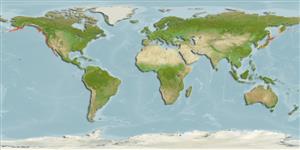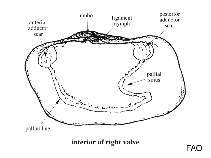Panopea abrupta (Conrad, 1849)
Pacific geoduck clam| Native range | All suitable habitat | Point map | Year 2050 |

|
| This map was computer-generated and has not yet been reviewed. |
| Panopea abrupta AquaMaps Data sources: GBIF OBIS |
Upload your photos
Google image | No image available for this species;
drawing shows typical species in Hiatellidae.
Google image | No image available for this species;
drawing shows typical species in Hiatellidae.
Classification / Names Common names | Synonyms | CoL | ITIS | WoRMS
Bivalvia | Adapedonta | Hiatellidae
Environment: milieu / climate zone / depth range / distribution range Ecology
Benthic; depth range 0 - 110 m (Ref. 78828). Temperate, preferred 8°C (Ref. 107945); 59°N - 23°N, 129°E - 106°W
Distribution Countries | FAO areas | Ecosystems | Occurrences | Introductions
Pacific Ocean: from Gangwon, South Korea to East Bering Sea, Alaska south to Baja California, Mexico.
Length at first maturity / Size / Weight / Age
Maturity: Lm ? range ? - ? cmCommon length : 21.2 cm SHL male/unsexed; (Ref. 78831); max. published weight: 2.8 kg (Ref. 127152); max. reported age: 168 years (Ref. 127152)
Buries in a variety of substrates, mud, sand and gravel, along the intertidal zone (Ref. 95344).
Life cycle and mating behavior Maturity | Reproduction | Spawning | Eggs | Fecundity | Larvae
Simple annual reproductive cycle: gametogenesis begins in September, spawning begins from March to July.
Main reference
References | Coordinator | Collaborators
Bisby, F.A., M.A. Ruggiero, K.L. Wilson, M. Cachuela-Palacio, S.W. Kimani, Y.R. Roskov, A. Soulier-Perkins and J. van Hertum. 2005. (Ref. 19)
IUCN Red List Status (Ref. 130435)
CITES status (Ref. 108899)
Not Evaluated
CMS (Ref. 116361)
Not Evaluated
Threat to humans
Human uses
Fisheries: commercial
FAO - Aquaculture: production; Fisheries: landings | FishSource | Sea Around Us
Tools
More information
Internet sources
BHL | BOLD Systems | CISTI | DiscoverLife | FAO(Fisheries: ; publication : search) | Fishipedia | GenBank (genome, nucleotide) | GloBI | Gomexsi | Google Books | Google Scholar | Google | PubMed | Tree of Life | Wikipedia (Go, Search) | Zoological Record
Estimates based on models
Preferred temperature
(Ref. 115969): 5.7 - 20.6, mean 12.1 (based on 518 cells).
Resilience
(Ref. 69278):
Medium, minimum population doubling time 1.4 - 4.4 years (K=0.11-0.49; tm=3.33; tmax=168).
Prior r = 0.37, 95% CL = 0.24 - 0.55, Based on 1 data-limited stock assessment.
Nutrients: Calcium = 149 [71, 228] mg/100g; Iron = 8.53 [1.95, 15.11] mg/100g; Protein = 9.88 [8.64, 11.12] %; Omega3 = 0.313 [0.202, 0.423] g/100g; Selenium = 61 [50, 72] μg/100g; VitaminA = 0 μg/100g; Zinc = 2.04 [0.56, 3.51] mg/100g (wet weight).



